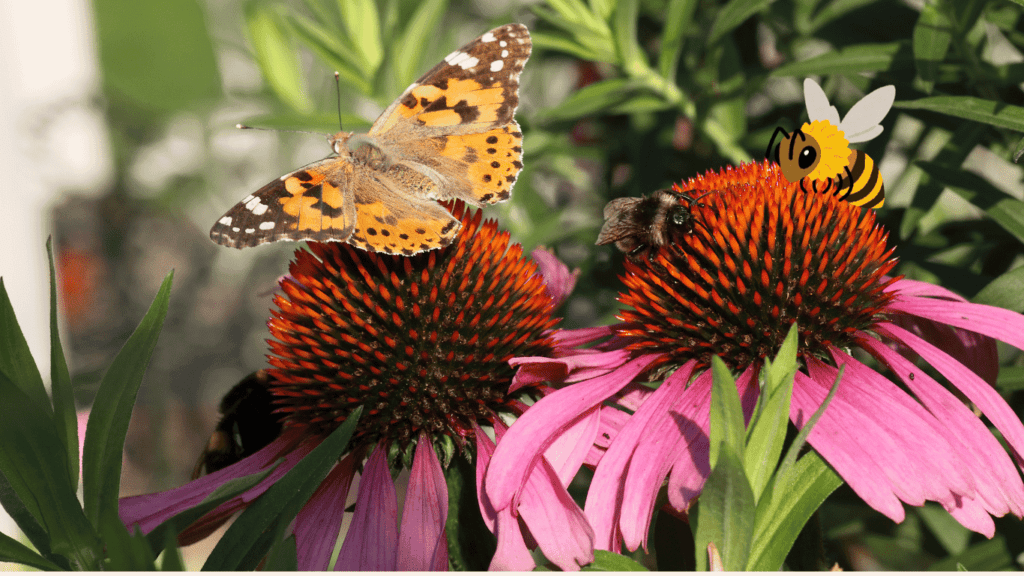
Why Attract Bees and Butterflies to Your Garden
Pollination Benefits
Bees and butterflies are crucial pollinators. They transfer pollen from one flower to another, enabling plants to produce seeds and fruit. Without them, many plants, including those that make up our food supply, would struggle to reproduce.
Biodiversity and Ecosystem Health
By attracting different pollinators, you help enhance biodiversity in your area. A rich variety of species makes the ecosystem stronger and more capable of coping with environmental challenges.
Aesthetic and Enjoyment
There’s something magical about a garden buzzing with bees and flitting with butterflies. These creatures add life and movement to your garden, making it a more enjoyable and serene space. So let’s Find out What Plants Attract Bees and Butterflies?
Characteristics of Plants That Attract Bees
Flower Color and Shape
Bees are especially attracted to flowers that are blue, purple, or yellow. They also prefer flowers that are flat or tubular, providing easy access to nectar.
Scent and Nectar Production
Strongly scented flowers are a beacon for bees. Additionally, plants that produce abundant nectar are highly attractive to these pollinators.
Bloom Time and Duration
Plants that bloom in the spring and summer are ideal for attracting bees. Having a variety of plants that bloom at different times ensures that bees have a continuous food source.
Top Plants to Attract Bees
Lavender
Lavender is a favorite among bees. Its vibrant purple flowers and soothing scent make it a garden staple.
Planting and Care Tips:
- Plant in well-drained soil.
- Ensure it gets full sun.
- Prune annually to maintain shape and promote growth.
Sunflowers
Sunflowers are not only beautiful but also a great food source for bees.
Planting and Care Tips:
- Place the plant in a sunny spot with soil that drains well.
- Water regularly, especially during dry periods.
- Stake tall varieties to prevent them from falling over.
Borage
Borage is known for its star-shaped blue flowers and is a magnet for bees.
Planting and Care Tips:
- Make sure to place the plant where it can get plenty of sun and the soil drains easily.
- Water moderately.
- Deadhead spent flowers to encourage more blooms.
Clover
Clover, particularly white clover, is highly attractive to bees.
Planting and Care Tips:
- Place the plant where it gets plenty of sun or partial shade for optimal growth.
- Tolerates poor soil but thrives in well-drained soil.
- Mow occasionally to keep it from becoming too tall.
Rosemary
Rosemary’s small blue flowers and aromatic leaves make it a dual-purpose plant for both culinary and bee-attracting purposes.
Planting and Care Tips:
- Plant in well-drained soil.
- Ensure it gets full sun.
- Regularly prune to keep its shape and promote fresh growth.
Characteristics of Plants That Attract Butterflies
Flower Color and Shape
Butterflies are attracted to bright colors like red, orange, pink, and purple. They prefer flowers that provide a landing platform.
Scent and Nectar Production
Fragrant flowers with abundant nectar are ideal for attracting butterflies.
Bloom Time and Duration
Like bees, butterflies need a consistent food source. Planting a variety of flowers that bloom at different times will keep them coming to your garden all season long.
Top Plants to Attract Butterflies
Butterfly Bush
The butterfly bush lives up to its name by attracting butterflies like a magnet.
Planting and Care Tips:
- Plant in full sun.
- Water regularly but don’t overwater.
- Trimming in early spring encourages strong new growth.
Milkweed
Milkweed is essential for monarch butterflies, as it’s the only plant their caterpillars eat.
Planting and Care Tips:
- Plant in a sunny spot.
- Prefers well-drained soil.
- Water moderately.
Coneflower
Coneflowers are not only beautiful but also a great nectar source for butterflies.
Planting and Care Tips:
- Plant in full sun.
- Water regularly during dry periods.
- Deadhead spent flowers to encourage more blooms.
Lantana
Lantana’s clusters of brightly colored flowers are irresistible to butterflies.
Planting and Care Tips:
- Plant in full sun.
- Tolerates poor soil but prefers well-drained soil.
- Water moderately.
Zinnias
Zinnias are easy to grow and come in a variety of bright colors, making them a favorite for butterflies.
Planting and Care Tips:
- Plant in full sun.
- Water regularly.
- Remove faded flowers to encourage more blooms throughout the season.
Creating a Bee and Butterfly Friendly Garden
Planting Strategies
Group similar plants together to make it easier for bees and butterflies to find them. Plant a variety of flowers that bloom at different times to make sure there’s always food available.
Water and Shelter
Provide shallow water sources, like birdbaths with stones for landing, to help bees and butterflies stay hydrated. Planting dense shrubs can offer shelter from wind and predators.
Avoiding Pesticides
Pesticides can be harmful to bees and butterflies. Use natural pest control methods to keep your garden safe for these important pollinators.
Conclusion
Creating a garden that attracts bees and butterflies is a rewarding endeavor. It not only enhances the beauty of your outdoor space but also supports the vitality and diversity of your local ecosystem. Begin by incorporating plants known to attract bees and butterflies, and watch as your garden becomes a vibrant hub of pollinator activity.
